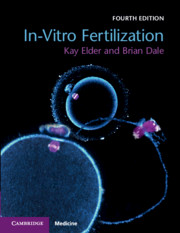Book contents
- In-Vitro Fertilization
- In-Vitro Fertilization
- Copyright page
- Contents
- Preface
- Acknowledgments
- Chapter 1 Review of Cell and Molecular Biology
- Chapter 2 Endocrine Control of Reproduction
- Chapter 3 Gametes and Gametogenesis
- Chapter 4 Gamete Interaction
- Chapter 5 First Stages of Development
- Chapter 6 Implantation and Early Stages of Fetal Development
- Chapter 7 Stem Cell Biology
- Chapter 8 The Clinical In-Vitro Fertilization Laboratory
- Chapter 9 Quality Management in the IVF Laboratory
- Chapter 10 Sperm and ART
- Chapter 11 Oocyte Retrieval and Embryo Culture
- Chapter 12 Cryopreservation of Gametes and Embryos
- Chapter 13 Micromanipulation Techniques
- Chapter 14 Preimplantation Genetic Diagnosis
- Chapter 15 Epigenetics and Human Assisted Reproduction
- Index
- References
Chapter 3 - Gametes and Gametogenesis
Published online by Cambridge University Press: 24 December 2019
- In-Vitro Fertilization
- In-Vitro Fertilization
- Copyright page
- Contents
- Preface
- Acknowledgments
- Chapter 1 Review of Cell and Molecular Biology
- Chapter 2 Endocrine Control of Reproduction
- Chapter 3 Gametes and Gametogenesis
- Chapter 4 Gamete Interaction
- Chapter 5 First Stages of Development
- Chapter 6 Implantation and Early Stages of Fetal Development
- Chapter 7 Stem Cell Biology
- Chapter 8 The Clinical In-Vitro Fertilization Laboratory
- Chapter 9 Quality Management in the IVF Laboratory
- Chapter 10 Sperm and ART
- Chapter 11 Oocyte Retrieval and Embryo Culture
- Chapter 12 Cryopreservation of Gametes and Embryos
- Chapter 13 Micromanipulation Techniques
- Chapter 14 Preimplantation Genetic Diagnosis
- Chapter 15 Epigenetics and Human Assisted Reproduction
- Index
- References
Summary
After a blastocyst has implanted in the uterus and begins to differentiate into the three primary germ layers, a special population of cells develops as primordial germ cells (PGCs). These are destined to become the gametes of the new individual: future reproduction of the organism is absolutely dependent upon the correct development of these unique populations of cells. They originate immediately behind the primitive streak in the extraembryonic mesoderm of the yolk sac; toward the end of gastrulation they move into the embryo via the allantois, and temporarily settle in the mesoderm and endoderm of the primitive streak. In humans, PGCs can be identified at about 3 weeks of gestation, close to the yolk sac endoderm at the root of the allantois.
- Type
- Chapter
- Information
- In-Vitro Fertilization , pp. 53 - 76Publisher: Cambridge University PressPrint publication year: 2020



